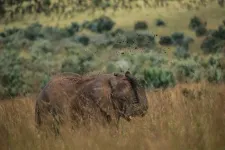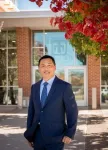(Press-News.org) For millions of years, a variety of large herbivores, or megafauna, influenced terrestrial ecosystems. Among many others, these included elephants in Europe, giant wombats in Australia, and ground sloths in South America. However, these animals experienced a wave of extinctions coinciding with the worldwide expansion of humans, leading to dramatic but still not fully understood changes in ecosystems. Even the survivors of these extinctions strongly declined, and many are currently threatened with extinction.
While there are many case studies as well as theories about the effects of large animals, formal attempts to quantitatively synthesize their effects and establish generality have been lacking.
A new study, conducted by an international team led by researchers from Aarhus University and the University of Göttingen, published in Nature Ecology & Evolution, has gathered numerous individual case studies and analyzed the findings. They show that large animals have a variety of generalizable impacts – impacts that are likely missing from most of today’s ecosystems.
The impact of large animals on ecosystems
Among the identified general impacts of large wild herbivores are
shifts in soil and plant nutrients
the promotion of open and semi-open vegetation
the regulation of the population of smaller animals
Moreover, one of the key findings of the studies is that megafauna promote ecosystem diversity by increasing the structural variability in the vegetation.
“The positive impact on variability in vegetation structure is particularly noteworthy, given that environmental heterogeneity is known as a universal driver of biodiversity. While our study mostly looked at the impact of megafauna on small scales, our findings suggest that they promote biodiversity even on the landscape level,” says PhD student at Aarhus University Jonas Trepel, who led the study.
Large herbivores change vegetation structure by consuming biomass, breaking woody plants, and trampling smaller plants – impacts that are hypothesized to depend on the animal’s body size. Given that the analyzed dataset spanned two magnitudes of body size (45-4500 kg), the researchers were able to test specifically how this important trait shapes the impact of large animals. They found, for example, that megafauna communities which include larger herbivores tend to have positive effects on local plant diversity, while communities composed of smaller species (e.g. <100 kg) tend to decrease local plant diversity.
“Large herbivores can eat lower-quality food such as branches and stems, which may result in proportionally greater impacts on dominant plant species and thus give less competitive plants better odds in their struggle for sunlight and space,” explains Erick Lundgren, one of the senior authors of the study.
Assistant professor Elizabeth le Roux, who is also one of the senior authors, adds:
“These findings support the expectation that many small herbivores cannot fully compensate for the loss of a few large ones."
The benefits of a meta-analysis
This study is a so-called meta-analysis. This means that the researchers have analyzed data from all available studies on the subject in order to find general patterns. Meta-analyses are especially powerful in their conclusions because they draw on big data pools and make it possible to draw conclusions that go beyond a local context.
While many recent ecological studies have shown or hypothesized the importance of large animals in ecosystems, according to senior author Jens-Christian Svenning, the meta-analytical study is an important step forward by synthesizing direct experimental and semi-experimental evidence from across the globe to assess the generality of these effects quantitatively.
“This global meta-analysis shows that large herbivores have important general effects on ecosystems and their biodiversity," explains professor Jens-Christian Svenning, continuing: “Importantly, our analysis shows that these effects cut across a broad range of ecologically important phenomena, from soil conditions to vegetation structure to plant and animal species composition, affecting not only their general state but also their variation across landscapes.”
Jens-Christian Svenning is the director of Center for Ecological Dynamics in a Novel Biosphere (ECONOVO), a Danish National Research Foundation center of excellence at Aarhus University.
Fact box: How did the researchers get these results?
A key aspect of the 297 studies, including 5,990 individual data points, is that the researchers compare adjacent areas with clear differences in the megafauna community (i.e. megafauna present or absent) due to known reasons. The vast majority of studies in the data set are so-called exclosure studies, in which some parts of a field site are fenced up to prevent large animals from entering. By comparing different plots inside and outside of the fences, researchers are then able to assess in which ways megafauna impact the ecosystem.
Importance of ecosystem biodiversity in responding to global change
The identified general importance of large herbivores for ecosystem functioning implies that important functions are missing due to the loss of wild megafauna. This may affect the approach to nature conservation and ecosystem restoration.
“The majority of today’s protected areas are missing large animals – and thus also an important range of functions. So even areas we consider to be pristine ecosystems are probably not as natural as we may think. Reintroducing large animals could be a key avenue to make these areas a bit more dynamic and used to disturbances,” says Jonas Trepel and continues:
“By increasing the structural variability in an ecosystem, large animals may provide refuges, for example during extreme weather events, but also open up more available niches for other species. This could prevent one or a few species from dominating and allows species with similar ecological attributes to coexist – which in turn would make the ecosystem more resilient. Ultimately, that may help them to deal with the consequences of global change.”
Given the important functions that large animals have on ecosystems and their biodiversity, the researchers conclude that it is crucial to not just protect the few remaining megafauna species, but also to reestablish megafauna populations as part of restoration efforts to achieve positive outcomes for Earth's biosphere, not least under the increasingly unprecedented global environmental conditions.
END
Global study: Wild megafauna shape ecosystem properties
A new meta-analysis across six continents establishes that large wild herbivores affect ecosystems in numerous important ways, from soils to vegetation to smaller animals and promote ecosystem variability
2024-02-09
ELSE PRESS RELEASES FROM THIS DATE:
Towards A Better Way of Releasing Hydrogen Stored in Hydrogen Boride Sheets
2024-02-09
The looming threat of climate change has motivated scientists worldwide to look for cleaner alternatives to fossil fuels, and many believe hydrogen is our best bet. As an environmentally friendly energy resource, hydrogen (H2) can be used in vehicles and electric power plants without releasing carbon dioxide into the atmosphere.
However, storing and transporting H2 safely and efficiently remains a challenge. Compressed gaseous hydrogen poses a significant risk of explosion and leakage, whereas liquid hydrogen must be maintained at extremely low temperatures, ...
Language barriers could contribute to higher aggression in people with dementia
2024-02-09
Immigrants living with dementia were more likely to present with agitation and aggression compared with their non-immigrant counterparts, a new study by Edith Cowan University (ECU) in collaboration with The Dementia Centre, HammondCare, found.
Researchers from ECU’s Centre for Research in Aged Care and HammondCare’s The Dementia Centre noted that behaviours and psychological symptoms of dementia (BPSD), such as agitation and aggression, are common; however, its presentation may be influenced by the cultural background of the person.
A study investigated differences in clinical and demographics characteristics ...
Conversion process turns greenhouse gas into ethylene
2024-02-09
Engineers at the University of Cincinnati created a more efficient way of converting carbon dioxide into valuable products while simultaneously addressing climate change.
In his chemical engineering lab in UC’s College of Engineering and Applied Science, Associate Professor Jingjie Wu and his team found that a modified copper catalyst improves the electrochemical conversion of carbon dioxide into ethylene, the key ingredient in plastic and a myriad of other uses.
Ethylene has been called ...
Predicting psychosis before it occurs
2024-02-09
The onset of psychosis can be predicted before it occurs, using a machine-learning tool which can classify MRI brain scans into those who are healthy and those at risk of a psychotic episode. An international consortium including researchers from the University of Tokyo, used the classifier to compare scans from over 2,000 people from 21 global locations. About half of the participants had been identified as being clinically at high risk of developing psychosis. Using training data, the classifier was 85% accurate at differentiating between people ...
New research shows students' knowledge and perceptions of active learning declined during pandemic-era teaching
2024-02-09
Students’ knowledge and perceptions of active learning declined significantly during COVID-induced remote teaching and have not recovered to pre-pandemic levels, according to new research from Chapman University Assistant Professor Jeremy Hsu.
Hsu says the benefits of active learning – exercises like group projects, problem-solving and class discussions – are well documented, but he emphasizes that students’ understanding and perceptions of the practice can affect their level of engagement and investment. If students have limited exposure or are hesitant to participate in active learning practices, resistance could ...
Evaluating the performance of AI-based large language models in radiation oncology
2024-02-09
A new study evaluates an artificial intelligence (AI)-based algorithm for autocontouring prior to radiotherapy in head and neck cancer. Manual contouring to pinpoint the area of treatment requires significant time, and an AI algorithm to enable autocontouring has been introduced. The study is published in the peer-reviewed journal AI in Precision Oncology. Click here to read the article now.
Nikhil Thaker, from Capital Health and Bayta Systems, and coauthors, evaluated the performance of various LLMs, including OpenAI’s GPT-3.5-turbo, GPT-4, GPT-4-turbo, ...
Sandia awarded for outstanding work in technology transfer
2024-02-09
ALBUQUERQUE, N.M. — One of Sandia National Laboratories’ core missions is to help the world through innovation.
However, transferring some of that innovation from the Labs to industry isn’t always an easy process.
Through hard work and ingenuity, some Sandia employees are excelling at moving technology to market, a feat that is now being honored by the Federal Laboratory Consortium. The consortium, composed of more than 300 members nationwide, provides a forum to develop strategies and opportunities for linking laboratory technologies and expertise in the marketplace.
Regional Technology Transfer Award: Disinfectant ...
Evaluating AI-based nodal contouring in head and neck cancer
2024-02-09
A new study evaluates an artificial intelligence (AI)-based algorithm for autocontouring prior to radiotherapy in head and neck cancer. Manual contouring to pinpoint the area of treatment requires significant time, and an AI algorithm to enable autocontouring has been introduced. The study is published in the peer-reviewed journal AI in Precision Oncology. Click here to read the article now.
Sushil Beriwal, from Allegheny Health Network, and Varian, and coauthors, analyzed 108 patients ...
The Lancet: Black women in the USA were murdered six times more often than White women between 1999 and 2020, state-level analysis indicates
2024-02-09
Analysis of racial disparities in US homicide rates indicates Black women were on average six times more likely to die by homicide than White women between 1999 and 2020.
Homicide rates among Black women were significantly higher than for White women in all 30 states analysed, with some evidence suggesting the biggest differences are in states with the highest racial inequities.
The greatest disparity in homicide rates was in Wisconsin in 2019-2020, when Black women were 20 times more likely to be ...
Study shows clinical benefit of new way of treating advanced ER+ breast cancer
2024-02-09
A research paper published today (8 February 2024) in The Lancet Oncology demonstrates that the drug enobosarm, a selective androgen receptor modulator which stimulates the male sex hormone receptor has anti-tumour effects in oestrogen receptor positive breast cancer patients.
Lead author Professor Carlo Palmieri from the University of Liverpool and The Clatterbridge Cancer Centre NHS Foundation Trust, said: “These results are very encouraging – we have shown that in advanced/metastatic breast cancer ...
LAST 30 PRESS RELEASES:
Tunnel resilience models unveiled to aid post-earthquake recovery
Satellite communication systems: the future of 5G/6G connectivity
Space computing power networks: a new frontier for satellite technologies
Experiments advance potential of protein that makes hydrogen sulfide as a therapeutic target for Alzheimer’s disease
Examining private equity’s role in fertility care
Current Molecular Pharmacology achieves a landmark: real-time CiteScore advances to 7.2
Skeletal muscle epigenetic clocks developed using postmortem tissue from an Asian population
Estimating unemployment rates with social media data
Climate policies can backfire by eroding “green” values, study finds
Too much screen time too soon? A*STAR study links infant screen exposure to brain changes and teen anxiety
Global psychiatry mourns Professor Dan Stein, visionary who transformed mental health science across Africa and beyond
KIST develops eco-friendly palladium recovery technology to safeguard resource security
Statins significantly reduce mortality risk for adults with diabetes, regardless of cardiovascular risk
Brain immune cells may drive more damage in females than males with Alzheimer’s
Evidence-based recommendations empower clinicians to manage epilepsy in pregnancy
Fungus turns bark beetles’ defenses against them
There are new antivirals being tested for herpesviruses. Scientists now know how they work
CDI scientist, colleagues author review of global burden of fungus Candida auris
How does stroke influence speech comprehension?
B cells transiently unlock their plasticity, risking lymphoma development
Advanced AI dodel predicts spoken language outcomes in deaf children after cochlear implants
Multimodal imaging-based cerebral blood flow prediction model development in simulated microgravity
Accelerated streaming subgraph matching framework is faster, more robust, and scalable
Gestational diabetes rose every year in the US since 2016
OHSU researchers find breast cancer drug boosts leukemia treatment
Fear and medical misinformation regarding risk of progression or recurrence among patients with breast cancer
Glucagonlike peptide-1 receptor agonists and asthma risk in adolescents with obesity
Reviving dormant immunity: Millimeter waves reprogram the immunosuppressive microenvironment to potentiate immunotherapy without obvious side effects
Safety decision-making for autonomous vehicles integrating passenger physiological states by fNIRS
Fires could emit more air pollution than previously estimated
[Press-News.org] Global study: Wild megafauna shape ecosystem propertiesA new meta-analysis across six continents establishes that large wild herbivores affect ecosystems in numerous important ways, from soils to vegetation to smaller animals and promote ecosystem variability








